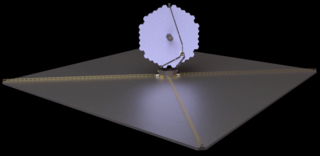Alan Michael Dressler (born 23 March 1948) is an American astronomer at the Carnegie Institution for Science of Washington, D.C. Among his works is the popularization Voyage To The Great Attractor: Exploring Intergalactic Space. [1]
Dressler was born in Cincinnati, Ohio, graduated from Walnut Hills High School [2] in 1966, and received his bachelor's degree in physics in 1970 from the University of California, Berkeley and his doctorate in astronomy in 1976 from the University of California, Santa Cruz. His primary professional interests lie in cosmology, birth and evolution of galaxies, astronomical instrumentation, and extragalactic astronomy.
From 1993 to 1995 Dressler chaired the Association of Universities for Research in Astronomy (AURA) committee "HST & Beyond: Exploration and the Search for Origins" that provided NASA with the document "A Vision for Ultraviolet-Optical-Infrared Space Astronomy". [3] [4] He was a member of the Nuker Team and the Morphs collaboration which studied the evolution of spiral galaxies using the Magellan Telescopes and the Hubble Space Telescope. [5] Dressler was chairman of the Origins Subcommittee (OS) for NASA from 2000 to 2003, [6] but declined membership in the Review of Near-Earth Object Surveys and Hazard Mitigation Strategies, Survey/Detection Panel. [7] Dressler is currently working on the Inamori Magellan Areal Camera and Spectrograph (IMACS) Cluster Building Survey which studies the evolution of stellar structures and populations in distant galaxy clusters, which means the events observed took place four to seven billion years ago. He is also a member of the Terrestrial Planet Finder Coronograph Science and technology definition team. [8]
In 1983 Dressler received the Newton Lacy Pierce Prize in Astronomy from the American Astronomical Society [9] He was elected to the United States National Academy of Sciences in the field of astronomy in 1996. [10] In 1999 he received the Public Service Medal from NASA. In 2017 the AURA "HST and Beyond" Committee, chaired by Dressler, was awarded the Carl Sagan Memorial Award. [11]

The following outline is provided as an overview and topical guide to space science:

The Hubble Space Telescope is a space telescope that was launched into low Earth orbit in 1990 and remains in operation. It was not the first space telescope, but it is one of the largest and most versatile, renowned as a vital research tool and as a public relations boon for astronomy. The Hubble telescope is named after astronomer Edwin Hubble and is one of NASA's Great Observatories. The Space Telescope Science Institute (STScI) selects Hubble's targets and processes the resulting data, while the Goddard Space Flight Center (GSFC) controls the spacecraft.

Astronomy is a natural science that studies celestial objects and the phenomena that occur in the cosmos. It uses mathematics, physics, and chemistry in order to explain their origin and their overall evolution. Objects of interest include planets, moons, stars, nebulae, galaxies, meteoroids, asteroids, and comets. Relevant phenomena include supernova explosions, gamma ray bursts, quasars, blazars, pulsars, and cosmic microwave background radiation. More generally, astronomy studies everything that originates beyond Earth's atmosphere. Cosmology is a branch of astronomy that studies the universe as a whole.

The Space Telescope Science Institute (STScI) is the science operations center for the Hubble Space Telescope (HST), science operations and mission operations center for the James Webb Space Telescope (JWST), and science operations center for the Nancy Grace Roman Space Telescope. STScI was established in 1981 as a community-based science center that is operated for NASA by the Association of Universities for Research in Astronomy (AURA). STScI's offices are located on the Johns Hopkins University Homewood Campus and in the Rotunda building in Baltimore, Maryland.

The National Optical Astronomy Observatory (NOAO) was the United States national observatory for ground-based nighttime ultraviolet-optical-infrared (OUVIR) astronomy. The National Science Foundation (NSF) funded NOAO to provide forefront astronomical research facilities for US astronomers. Professional astronomers from any country in the world could apply to use the telescopes operated by NOAO under the NSF's "open skies" policy.

The Association of Universities for Research in Astronomy (AURA) is a consortium of universities and other institutions that operates astronomical observatories and telescopes.

NASA's series of Great Observatories satellites are four large, powerful space-based astronomical telescopes launched between 1990 and 2003. They were built with different technology to examine specific wavelength/energy regions of the electromagnetic spectrum: gamma rays, X-rays, visible and ultraviolet light, and infrared light.
The Carl Sagan Memorial Award is an award presented jointly by the American Astronautical Society and The Planetary Society to an individual or group "who has demonstrated leadership in research or policies advancing exploration of the Cosmos." The annual award, first presented in 1997, was created in honor of American astronomer, astrobiologist and science popularizer, Carl Sagan (1934–1996).

The Cosmic Origins Spectrograph (COS) is a science instrument that was installed on the Hubble Space Telescope during Servicing Mission 4 (STS-125) in May 2009. It is designed for ultraviolet (90–320 nm) spectroscopy of faint point sources with a resolving power of ≈1,550–24,000. Science goals include the study of the origins of large scale structure in the universe, the formation and evolution of galaxies, and the origin of stellar and planetary systems and the cold interstellar medium. COS was developed and built by the Center for Astrophysics and Space Astronomy (CASA-ARL) at the University of Colorado at Boulder and the Ball Aerospace and Technologies Corporation in Boulder, Colorado.
Marc Postman is an American astronomer at the Space Telescope Science Institute in Baltimore, Maryland, United States. His research interests include observational studies of the formation and evolution of galaxies and large scale structure in the universe. His work focuses on determining, observationally, the relationships between galaxy-scale phenomena and the surrounding large-scale environment and matter distribution. His recent research includes characterizing the properties of brightest cluster galaxies and placing new constraints on the cosmic optical background.

The Astronomy and Astrophysics Decadal Survey is a review of astronomy and astrophysics literature produced approximately every ten years by the National Research Council of the National Academy of Sciences in the United States. The report surveys the current state of the field, identifies research priorities, and makes recommendations for the coming decade. The decadal survey represents the recommendations of the research community to governmental agencies on how to prioritize scientific funding within astronomy and astrophysics. The editing committee is informed by topical panels and subcommittees, dedicated conferences, and direct community input in the form of white papers summarizing the state of the art in each subdiscipline. The most recent report, Astro2020, was released in 2021.
The Morphs collaboration was a coordinated study to determine the morphologies of galaxies in distant clusters and to investigate the evolution of galaxies as a function of environment and epoch. Eleven clusters were examined and a detailed ground-based and space-based study was carried out.
Christopher David Impey is a British astronomer, educator, and author. He has been a faculty member at the University of Arizona since 1986. Impey has done research on observational cosmology, in particular low surface brightness galaxies, the intergalactic medium, and surveys of active galaxies and quasars. As an educator, he has pioneered the use of instructional technology for teaching science to undergraduate non-science majors. He has written many technical articles and a series of popular science books including The Living Cosmos, How It Began, How It Ends: From You to the Universe, Dreams of Other Worlds, and Humble Before the Void. He served as Vice-President of the American Astronomical Society, he is a Fellow of the American Association for the Advancement of Science, and a Howard Hughes Medical Institute Professor. He serves on the Advisory Council of METI.

Jacob Noel-Storr is an astrophysics researcher and science education and outreach specialist researcher, Presently the lecturer for practical astronomy and X-Lab-PAM team leader at the University of Groningen and president of InsightSTEM, Inc. He was an assistant research professor and director of the Insight Lab for Science Outreach and Learning Research at Rochester Institute of Technology, and assistant staff scientist in the Steward Observatory and Flandrau Science Center at the University of Arizona. He is known for contributions to the study of Active Galactic Nuclei / Supermassive Black Holes, as well as science / astronomy education and outreach.

The Large Ultraviolet Optical Infrared Surveyor, commonly known as LUVOIR, is a multi-wavelength space telescope concept being developed by NASA under the leadership of a Science and Technology Definition Team. It is one of four large astrophysics space mission concepts studied in preparation for the National Academy of Sciences 2020 Astronomy and Astrophysics Decadal Survey.

Origins Space Telescope (Origins) is a concept study for a far-infrared survey space telescope mission. A preliminary concept in pre-formulation, it was presented to the United States Decadal Survey in 2019 for a possible selection to NASA's large strategic science missions. Origins would provide an array of new tools for studying star formation and the energetics and physical state of the interstellar medium within the Milky Way using infrared radiation and new spectroscopic capabilities.

Marcia Jean Rieke is an American astronomer. She is a Regents' Professor of Astronomy and associate department head at the University of Arizona. Rieke is the Principal Investigator on the near-infrared camera (NIRCam) for the James Webb Space Telescope (JWST). She has also served as the deputy-Principal Investigator on the Near Infrared Camera and Multi-Object Spectrometer (NICMOS) for the Hubble Space Telescope (HST), and as the co-investigator for the multiband imaging photometer on the Spitzer Space Telescope, where she also acted as an outreach coordinator and a member of the Science Working Group. Rieke was also involved with several infrared ground-based observatories, including the MMT Observatory in Arizona. She was vice chair for Program Prioritization of the Astro2010 Decadal Survey Committee, "New Worlds, New Horizons". Marcia Rieke is considered by many to be one of the "founding mothers" of infrared astronomy, along with Judith Pipher.

Kevin France is an astrophysicist and assistant professor in the Department of Astrophysical and Planetary Sciences at the University of Colorado. His research focuses on exoplanets and their host stars, protoplanetary disks, and the development of instrumentation for space-borne astronomy missions.
Hsiao-Wen Chen is a Taiwanese-American astronomer who uses a combination of absorption spectroscopy and emission-line mapping to study diffuse baryonic "normal matter" in the intergalactic medium and galactic halos, and the connections between this matter and the matter in star-forming regions of galaxies. The circumgalactic medium resides in the interface between star-forming regions and intergalactic space contains the majority of baryonic mass as well as the critical record of gas circulation in and out of galaxies. Chen, a professor of astronomy and astrophysics at the University of Chicago, has been leading efforts to decipher how the growth and evolution of galaxies over cosmic time are connected and/or regulated by the physical properties of the circumgalactic gas.
James Wellington Truran Jr. was an American physicist, known for his research in nuclear astrophysics.